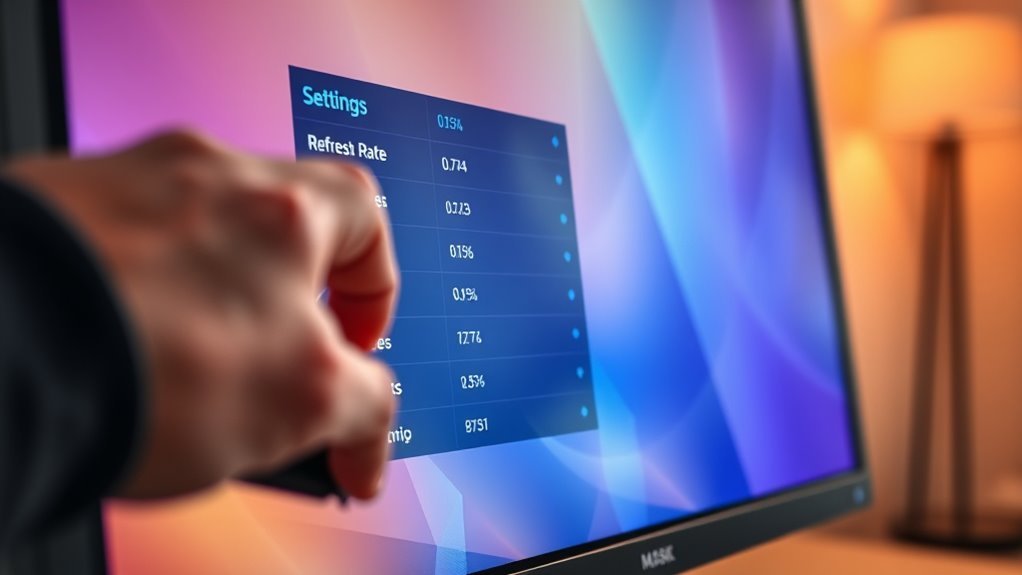To find your monitor’s refresh rate, right-click on your desktop and select “Display Settings” if you’re using Windows. Scroll to “Advanced display settings,” and you’ll see the refresh rate listed. For macOS users, click the Apple menu, go to “System Preferences,” and then “Displays” to find the refresh rate alongside resolution settings. Make sure to choose the highest supported rate for improved visuals. Stick around to explore how adjusting this setting can enhance your overall experience.
Understanding Refresh Rate
Refresh rate is an essential aspect of your monitor’s performance. It refers to how many times per second your display refreshes the image, typically measured in hertz (Hz). A higher refresh rate leads to smoother visuals, which is important for gaming, video editing, and fast-paced content. Depending on your needs, you’ll notice a significant refresh rate impact; for example, 60Hz might be sufficient for everyday tasks, while 120Hz or 144Hz can enhance your gaming experience. If you desire freedom in your activities, understanding refresh rates helps you choose a monitor that matches your lifestyle. Ultimately, selecting the right refresh rate can elevate your overall experience, providing you with the clarity and responsiveness you crave.
Checking Refresh Rate on Windows
Wondering how to check your monitor’s refresh rate on Windows? It’s easy! Just follow these steps to access your monitor settings:
- Right-click on your desktop and select “Display Settings.”
- Scroll down and click on “Advanced display settings.”
- Look for “Refresh rate” under the “Display information” section.
- Here, you’ll see the current refresh rate for each connected display.
- If needed, you can adjust it for better display performance by selecting a different rate.
Knowing your monitor’s refresh rate can enhance your gaming or viewing experience. So, take a moment to check it out and enjoy the freedom of smooth visuals!
Checking Refresh Rate on Macos
If you’re using macOS and want to check your monitor’s refresh rate, the process is straightforward. Start by clicking the Apple menu in the top left corner of your screen and select “System Preferences.” From there, navigate to “Displays.” Within the display preferences, you’ll see information about your monitor, including the refresh rate. If you have multiple displays connected, make certain to select the one you want to check. The refresh rate will typically be listed alongside the resolution settings. This simple step guarantees you’re aware of your monitor’s capabilities, helping you optimize your viewing experience. Knowing the refresh rate can enhance how you enjoy content or play games on your Mac.
Adjusting Refresh Rate Settings
While adjusting your monitor’s refresh rate can greatly enhance your visual experience, it’s essential to know how to do it correctly. Here’s a quick guide to optimizing performance through adjusting settings:
- Open your display settings.
- Look for the “Refresh Rate” option.
- Select the highest compatible refresh rate.
- Save your changes and exit.
- Test different settings to find what feels best for you.
Experimenting with these options can lead to a smoother experience, especially for gaming or multimedia tasks. Remember, not all monitors support higher refresh rates, so check your specifications. Adjusting these settings will empower you to tailor your display to your needs, ensuring you enjoy every moment on-screen.
Importance of Refresh Rate for Different Activities
Understanding the importance of refresh rate is crucial, especially since it can greatly impact your experience across various activities. For gamers, a higher refresh rate enhances gaming performance, making visuals smoother and reducing motion blur. This can give you a competitive edge, as every frame counts in fast-paced games. On the other hand, if you’re into video editing, a higher refresh rate guarantees more accurate color representation and smoother playback, allowing you to see your edits in real-time without lag. Ultimately, finding the right refresh rate for your monitor can enhance your enjoyment and productivity, whether you’re battling in a virtual arena or crafting the perfect video project. Choose wisely to elevate your experience.
Frequently Asked Questions
Can Refresh Rate Affect Battery Life on Laptops?
Yes, refresh rate can impact battery consumption on laptops. Higher refresh rates demand more power, leading to reduced battery life. Lowering the refresh rate can help prolong usage time, offering a balance between performance and longevity.
Do Different Cables Affect Monitor Refresh Rates?
“You get what you pay for.” Different cable types can greatly affect monitor refresh rates. Quality cables guarantee better signal quality, leading to smoother visuals. So, choose wisely for ideal performance and freedom in your gaming experience.
What Is the Maximum Refresh Rate for My Monitor?
Your monitor’s maximum refresh rate is typically listed in its specifications. Check the manufacturer’s website or user manual for precise details, ensuring you’re getting the best performance for your gaming or work experience.
How Does Refresh Rate Impact Gaming Performance?
Refresh rate directly impacts your gaming experience by determining how smoothly frame rates are displayed. A higher refresh rate reduces motion blur, providing clearer visuals and a more responsive feel, enhancing your overall enjoyment and performance.
Is There a Standard Refresh Rate for TVS?
While there’s no strict standard refresh rate, most TVs use 60Hz or 120Hz. When checking TV specifications, keep in mind that higher refresh rates often enhance motion clarity, allowing for a more enjoyable viewing experience.

